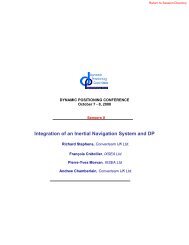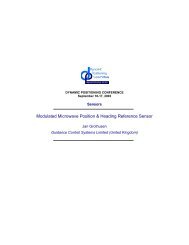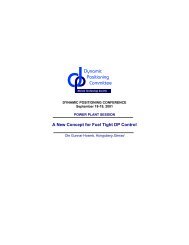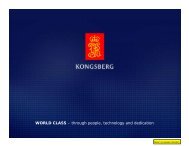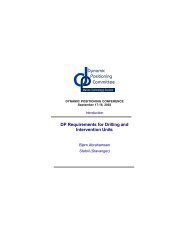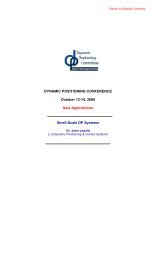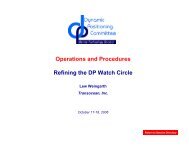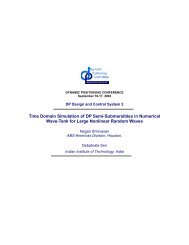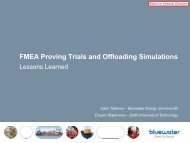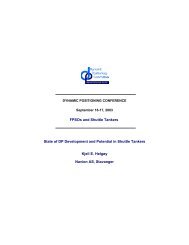Operability Study for DP Vessel Operations at a Deep water Spar-A ...
Operability Study for DP Vessel Operations at a Deep water Spar-A ...
Operability Study for DP Vessel Operations at a Deep water Spar-A ...
Create successful ePaper yourself
Turn your PDF publications into a flip-book with our unique Google optimized e-Paper software.
Author’s Name Name of the Paper SessionDYNAMIC POSITIONING CONFERENCEOctober 11-12, 2011NEW APPLICATIONS<strong>Operability</strong> <strong>Study</strong> <strong>for</strong> <strong>DP</strong> <strong>Vessel</strong> <strong>Oper<strong>at</strong>ions</strong> <strong>at</strong> a <strong>Deep</strong>w<strong>at</strong>er <strong>Spar</strong>-A Decision Support ToolBy Xiaobing Shi, American Global Maritime IncTorbjørn Hals, Kongsberg Maritime ASSuman Muddusetti, Shell Intern<strong>at</strong>ional Explor<strong>at</strong>ion and Production Inc.
Shi, Hals and Muddusetti<strong>Operability</strong> <strong>Study</strong> <strong>for</strong> <strong>DP</strong> <strong>Vessel</strong> <strong>Oper<strong>at</strong>ions</strong> <strong>at</strong> a <strong>Deep</strong>-w<strong>at</strong>er <strong>Spar</strong>1-AbstractThis paper describes the approach and methodology used to undertake an operability and uptimestudy <strong>for</strong> a gangway connected oper<strong>at</strong>ion of a <strong>DP</strong> vessel to a flo<strong>at</strong>ing production facility in orderto provide support to the construction and commissioning teams.Traditional operability and uptime studies focus on metocean conditions, vessel motions andvessel’s st<strong>at</strong>ion keeping capabilities. The objective of the study was focused onConsider the requirements of the vessel to oper<strong>at</strong>e within the established ActivitySpecific Oper<strong>at</strong>ing Guidelines (ASOG, project specific).Qualify and identify the <strong>DP</strong> control accuracy <strong>for</strong> various environmentalconditionsProvide practical guidance in execution planning to oper<strong>at</strong>ional and project teamsThe paper focuses on the approach and the iter<strong>at</strong>ive process between the participants to carry outtheir respective scopes which includedProject variables and ASOGDynamic Coupled motion analysis of the two bodies<strong>DP</strong> simul<strong>at</strong>ion work <strong>for</strong> rel<strong>at</strong>ive positioning using production facility motion timetracesThe approach adopted delivered results which were used to provide in<strong>for</strong>m<strong>at</strong>ion to support thedecision making process of:Project teamsOper<strong>at</strong>ional teams during execution2-IntroductionThe <strong>DP</strong> vessel is a multi Purpose Service <strong>Vessel</strong>, of 131.7 m in length, 22.0 m in width. Thevessel is equipped with the following thrusters: Two fixed pitch, Wärtsilä Propulsion Z type, converter driven, variable speed, azimuththrusters aft, each r<strong>at</strong>ed <strong>at</strong> 3000kW. Two CPP, constant speed Rolls Royce tunnel thrusters are fitted <strong>for</strong>ward, each r<strong>at</strong>ed <strong>at</strong>1335kW One CPP, constant speed Wärtsilä retractable azimuth thruster fitted <strong>for</strong>ward, r<strong>at</strong>ed <strong>at</strong>1200 kW.The dynamic position control is provided by Kongsberg K-POS <strong>DP</strong>2 system.The flo<strong>at</strong>ing pl<strong>at</strong><strong>for</strong>m is deep w<strong>at</strong>er spar moored to the seabed <strong>at</strong> 8000 feet of w<strong>at</strong>er depth withchains and polyester ropes. A bridge will be landing on vessel’s landing areas with the bridgeorigin<strong>at</strong>ing from the main deck of the <strong>Spar</strong>.The <strong>DP</strong> vessel will maintain st<strong>at</strong>ion using both rel<strong>at</strong>ive and absolute position reference systems,when gangway connected with the <strong>Spar</strong>. Under adverse we<strong>at</strong>her/environmental conditions, thegangway will be disconnected and the <strong>DP</strong> vessel will move away from the pl<strong>at</strong><strong>for</strong>m.MTS Dynamic Positioning Conference October 11-12, 2011 Page 1
Shi, Hals and Muddusetti<strong>Operability</strong> <strong>Study</strong> <strong>for</strong> <strong>DP</strong> <strong>Vessel</strong> <strong>Oper<strong>at</strong>ions</strong> <strong>at</strong> a <strong>Deep</strong>-w<strong>at</strong>er <strong>Spar</strong>The decision to disconnect the gangway is made when:The gangway predicted motion is beyond the acceptable limits of the landingarea on the <strong>DP</strong> vessel. The limits were predetermined and included in the ASOGgranting warning conditions <strong>for</strong> the oper<strong>at</strong>ional st<strong>at</strong>us. The <strong>DP</strong>O will followagreed instructions when these limits were reached. The actions ranged from anadvisory st<strong>at</strong>us to a complete disconnection. The advantage of this process is theimmedi<strong>at</strong>e action in response to an oper<strong>at</strong>ional limit reached.The Thruster capacity reached a pre-determined value indic<strong>at</strong>ed in the ASOG.These values were calcul<strong>at</strong>ed using this oper<strong>at</strong>ional study report and eachparticular thruster capacity and their combin<strong>at</strong>ion. This value considered theworst case scenario of loosing power or thruster failure.The <strong>DP</strong> system is designed to keep the vessel within specified position and heading limits. Inoper<strong>at</strong>ion the system toler<strong>at</strong>es transient errors in the thrusters and measurement systems and actsappropri<strong>at</strong>ely if a fault occurs. A self adapting Extended Kalman filter estim<strong>at</strong>es the vessel'sheading, position and velocities and the disturbances from sea current and waves. The estim<strong>at</strong>oruses an accur<strong>at</strong>e m<strong>at</strong>hem<strong>at</strong>ical model of the vessel. Kalman filtering technique using the modelprediction together with real measurements provides unsurpassed filtering quality, robustness andst<strong>at</strong>ion keeping per<strong>for</strong>mance. The Kalman filter autom<strong>at</strong>ically adapts to the quality of thereference systems as well as their d<strong>at</strong>a r<strong>at</strong>es. All accepted reference systems are used <strong>at</strong> all timeswith optimal mix to avoid any discontinuity.In the Auto Position mode, the system autom<strong>at</strong>ically controls the position and heading of thevessel rel<strong>at</strong>ive to a fixed wanted position / heading (setpoint).In Follow Target mode, the system autom<strong>at</strong>ically controls the position and heading of the vesselrel<strong>at</strong>ive to another moving object (ROV, vessel, moored structure). This mode of oper<strong>at</strong>ion ispreferred when the dynamics of the moving object is significant. Refer to [2] <strong>for</strong> control aspectson the Rel<strong>at</strong>ive Positioning. The issue on a “significant” motion of the other object and theconsequence <strong>for</strong> selection of position reference systems is also briefly handled in [3] . <strong>DP</strong>simul<strong>at</strong>ions per<strong>for</strong>med as part of this operability study are all based on “Follow Target”oper<strong>at</strong>ional mode and a mixture of absolute and rel<strong>at</strong>ive position reference systems. (Absolutesystems <strong>for</strong> vessel positioning and rel<strong>at</strong>ive <strong>for</strong> autom<strong>at</strong>ic upd<strong>at</strong>e of setpoints).A dynamic coupled motion analysis of the two-body <strong>for</strong> different wave headings was firstper<strong>for</strong>med. The purpose of the motion analysis is to calcul<strong>at</strong>e the rel<strong>at</strong>ive motion of the twoflo<strong>at</strong>ing bodies and provide a first-guess of the maximum allowable environment in which thegangway can be connected.The total ship motion can be regarded as a superposition of a low frequency component (due tothe wind, sea currents and thruster <strong>for</strong>ces and moments) and an oscill<strong>at</strong>ory term (the waveinduced wave frequency motion, wave period from 3-30 seconds), which represents the effect ofthe waves. Since the <strong>DP</strong> vessel’s motions are controlled using rel<strong>at</strong>ive position referencesystems, the gangway availability study disregards slowly varying motions from the total rel<strong>at</strong>ivemotions. It is assumed th<strong>at</strong> the <strong>DP</strong> system will control the low-frequency motions.To qualify the <strong>DP</strong> control accuracy <strong>for</strong> various environmental conditions, a <strong>DP</strong> simul<strong>at</strong>ion studywas per<strong>for</strong>med using the spar motion time-traces. The time-traces are total vessel motionincluding the low-frequency and high-frequency wave motions. Since <strong>DP</strong> only considers the slowvari<strong>at</strong>ions, the motion due to the waves is removed be<strong>for</strong>e it enters in the controller algorithm.MTS Dynamic Positioning Conference October 11-12, 2011 Page 2
Shi, Hals and Muddusetti<strong>Operability</strong> <strong>Study</strong> <strong>for</strong> <strong>DP</strong> <strong>Vessel</strong> <strong>Oper<strong>at</strong>ions</strong> <strong>at</strong> a <strong>Deep</strong>-w<strong>at</strong>er <strong>Spar</strong><strong>Vessel</strong> d<strong>at</strong>a (hydrodynamic parameters and thruster <strong>for</strong>ces) as implemented onboard the vesselwere used <strong>for</strong> the simul<strong>at</strong>ions. The limiting oper<strong>at</strong>ing criteria can be thus further fine-tuned basedon the findings of the <strong>DP</strong> simul<strong>at</strong>ion study.This study can provide practical guidance to the oper<strong>at</strong>ional and project teams. It is decisionsupport tool <strong>for</strong> determining when the <strong>DP</strong> vessel should be disconnected and safely moved awayfrom the pl<strong>at</strong><strong>for</strong>m.3-Analysis MethodA dynamic positioning system is a computer controlled system which autom<strong>at</strong>ically keeps avessel's position and heading by using propellers and thrusters. The computer program includes am<strong>at</strong>hem<strong>at</strong>ical model of the vessel which contains in<strong>for</strong>m<strong>at</strong>ion about the wind and current drag ofthe vessel and the loc<strong>at</strong>ion of the thrusters. This knowledge, combined with the sensorin<strong>for</strong>m<strong>at</strong>ion, helps the computer to calcul<strong>at</strong>e the required steering angle and thruster output <strong>for</strong>each thruster.In this operability study, a motion analysis was first per<strong>for</strong>med in MOSES to provide the positionand heading of the vessel rel<strong>at</strong>ive to the <strong>Spar</strong>. Time-domain motion analysis of the <strong>DP</strong> vessel andthe <strong>Spar</strong> was per<strong>for</strong>med <strong>for</strong> different wave headings <strong>for</strong> environmental bin 3-3.5m. The maximumgangway excursions under head, quartering and beams seas are summarized in Table 1, Table 2and Table 3 respectively. The <strong>DP</strong> vessel will remain gangway connected with the spar under theallowable we<strong>at</strong>her conditions. Under adverse we<strong>at</strong>her, the gangway will be disconnected and thevessel will move away from the pl<strong>at</strong><strong>for</strong>m.MOSES analysis model is used in this availability study. The objective of the motion analysis isModelling and Hydrodynamic calcul<strong>at</strong>ionsCalcul<strong>at</strong>e the relevant hydrodynamic and response parameters of <strong>Spar</strong>Calcul<strong>at</strong>e the hydrodynamic and response parameters of the vesselSet up a coupled two units system with the <strong>Spar</strong> moored to the seabedThe distance between the two supports on the vessel and spar is 40m approxim<strong>at</strong>ely. Thegangway is origin<strong>at</strong>ed from the <strong>Spar</strong>. The gangway’s wheels will roll across deck of the <strong>DP</strong>vessel. The approxim<strong>at</strong>e landing area <strong>for</strong> the bridge on <strong>DP</strong> vessel is 12mx7m.MTS Dynamic Positioning Conference October 11-12, 2011 Page 3
Shi, Hals and Muddusetti<strong>Operability</strong> <strong>Study</strong> <strong>for</strong> <strong>DP</strong> <strong>Vessel</strong> <strong>Oper<strong>at</strong>ions</strong> <strong>at</strong> a <strong>Deep</strong>-w<strong>at</strong>er <strong>Spar</strong>Figure 1: Hydrodynamic modelFigure 2: Bridge DetailsA <strong>DP</strong> simul<strong>at</strong>ion study was carried out to quality the <strong>DP</strong> control accuracy <strong>for</strong> variousenvironmental conditions. The <strong>DP</strong> simul<strong>at</strong>ion work used the spar and vessel motion time-tracescalcul<strong>at</strong>ed from MOSES motion analysis. The position and heading calcul<strong>at</strong>ed by hydrodynamicmodel are with two different frequency components. The wave-frequency components of theposition signals are reduced as part of the signal processing / Kalman filtering to prevent themfrom entering the thrusters. The <strong>DP</strong> was oper<strong>at</strong>ed in “Follow Target” mode and with medium tohigh controller gain settings dependent on the environmental conditions.The results from the <strong>DP</strong> simul<strong>at</strong>ion work provided detail in<strong>for</strong>m<strong>at</strong>ion about motion ranges andthruster demand to maintain st<strong>at</strong>ion keeping. These values can be used in the ASOG process toaccur<strong>at</strong>ely determine oper<strong>at</strong>ional st<strong>at</strong>us conditions and establish where the oper<strong>at</strong>ionalcontingency and action plan.MTS Dynamic Positioning Conference October 11-12, 2011 Page 4
Shi, Hals and Muddusetti<strong>Operability</strong> <strong>Study</strong> <strong>for</strong> <strong>DP</strong> <strong>Vessel</strong> <strong>Oper<strong>at</strong>ions</strong> <strong>at</strong> a <strong>Deep</strong>-w<strong>at</strong>er <strong>Spar</strong>4-Results4.1 Motion Analysis ResultsThe results are derived via MOSES time domain simul<strong>at</strong>ion on the basis of a 3-hour dur<strong>at</strong>ion.The maximum fwd-stern gangway movement is 2.9m <strong>for</strong> wave periods between 6.5 seconds and10.5 seconds, which is below the allowable movement of 12ft, i.e., 3.7m. However, <strong>for</strong> the longwave period waves, the maximum fwd-stern gangway movement has exceeded the landing arealimit. For these long wave period waves, the allowable Hs is 2.5m. The maximum port-stbdmovement is 5.7m with Hs=3.25m and Tp=14.5 sec, which is below the allowable movement of20ft, i.e., 6.1m, but does not s<strong>at</strong>isfy the tolerance of 0.5m assumed. There<strong>for</strong>e, the wave heightshould be reduced to 3.0m <strong>for</strong> this long wave period.Table 1: Heading Sea gangway movement in meter, Hs=3.25mHead SeaMax. fwdsternmovementMax. portstbdmovement6.5 0.7 0.07.5 1.0 0.18.5 1.2 0.19.5 1.5 0.110.5 2.9 0.111.5 4.3* 0.112.5 3.6* 0.113.5 3.8* 0.114.5 4.6* 0.1* exceed gangway limiting landing area. The wave height is lowered to 2.5m <strong>for</strong> these waveperiods. The maximum fwd-stern motion can be reduced to 3.0m.Table 2: Quartering Sea gangway movement in meter, Hs=3.25mQuartering SeaMax. fwdsternmovementMax. portstbdmovement6.5 0.5 1.57.5 0.7 1.68.5 0.7 1.89.5 0.8 1.610.5 0.7 2.211.5 0.7 3.312.5 0.8 3.213.5 0.8 2.614.5 1.0 2.9MTS Dynamic Positioning Conference October 11-12, 2011 Page 5
Shi, Hals and Muddusetti<strong>Operability</strong> <strong>Study</strong> <strong>for</strong> <strong>DP</strong> <strong>Vessel</strong> <strong>Oper<strong>at</strong>ions</strong> <strong>at</strong> a <strong>Deep</strong>-w<strong>at</strong>er <strong>Spar</strong>Table 3: Beam sea gangway movement in meter, Hs=3.25mBeam SeaMax. fwdsternmovementMax. portstbdmovement6.5 0.2 2.87.5 0.2 3.38.5 0.2 3.89.5 0.3 3.710.5 0.4 4.611.5 0.3 4.912.5 0.4 4.913.5 0.4 5.314.5 0.4 5.7** exceed gangway limiting landing area. The wave height is lowered to 3.0m <strong>for</strong> this wave period.The maximum port-stbd motion can be reduced to 5.3m.The maximum gangway movements <strong>for</strong> Hs=2.5m are added as part of iter<strong>at</strong>ive step to find outthe limiting environment condition, after the <strong>DP</strong> simul<strong>at</strong>ion study showed th<strong>at</strong> the thruster load istoo high <strong>for</strong> certain headings and wave periods.The results <strong>for</strong> Hs=2.5m are included in Table 4. The port-stbd gangway moments are 2.8m and3.6m <strong>for</strong> wave periods 7.5 seconds and 10.5 seconds respectively under beam-sea condition,which are below the allowable movement of 20ft, i.e., 6.1m.Table 4: Gangway movement in meter, Hs=2.5mMax. fwdsterstbdMax. port-Peak Period(sec)movement movementHead Seas7.5 0.9 0.110.5 2.2 0.1Quartering Seas7.5 0.5 1.510.5 0.5 1.6Beam Seas7.5 0.1 2.810.5 0.2 3.6MTS Dynamic Positioning Conference October 11-12, 2011 Page 6
Shi, Hals and Muddusetti<strong>Operability</strong> <strong>Study</strong> <strong>for</strong> <strong>DP</strong> <strong>Vessel</strong> <strong>Oper<strong>at</strong>ions</strong> <strong>at</strong> a <strong>Deep</strong>-w<strong>at</strong>er <strong>Spar</strong>Figure 3: Times series of the gangway movement, Hs=2.5m, Tp=7.5 sec, beam sea4.2 <strong>DP</strong> Simul<strong>at</strong>ion ResultsTwelve <strong>DP</strong> simul<strong>at</strong>ion cases were per<strong>for</strong>med with the following environmental parameters andassoci<strong>at</strong>ed motion time traces: Waves: Jonswap Wave spectrum with Gamma 2.0, Wave height andWave period varied according to table below). Wind speed: 17 m/s (API Wind spectrum) or 13 m/s Sea Current: 0.35 m/s.All directions will be collinear and with the direction defined in the table below. The 17 m/s windis estim<strong>at</strong>ed as the “maximum” expected wind speed to occur simultaneous with 3.25 m waves.Utiliz<strong>at</strong>ion of 13 m/s wind <strong>for</strong> the 2.5 meter wave-height hence gives slightly high thrustutiliz<strong>at</strong>ion. The initial cases 9 were defined <strong>for</strong> the maximum wind speed and maximum waveheight and maximum-average-minimum wave periods. Three additional cases with reducedenvironmental loads were added <strong>for</strong> the cases where the first simul<strong>at</strong>ions failed the oper<strong>at</strong>ionalcriteria <strong>for</strong> gangway connection.The decision to disconnect the gangway is made when: The gangway will move beyond the acceptable limits of the landing area on thevessel. The <strong>DP</strong> capacity of the <strong>DP</strong> vessel is over 50%The results from the simul<strong>at</strong>ion are summarized in the table below with respect to whether thecriteria <strong>for</strong> staying connected are met or not.MTS Dynamic Positioning Conference October 11-12, 2011 Page 7
Shi, Hals and Muddusetti<strong>Operability</strong> <strong>Study</strong> <strong>for</strong> <strong>DP</strong> <strong>Vessel</strong> <strong>Oper<strong>at</strong>ions</strong> <strong>at</strong> a <strong>Deep</strong>-w<strong>at</strong>er <strong>Spar</strong>Table 5: <strong>DP</strong> Simul<strong>at</strong>ion Results.3 The maximum devi<strong>at</strong>ion closest to or exceeding limit <strong>for</strong> given axis (x-surge, y-sway)4 The average load of the most loaded thruster is listed. In all cases where the load criterionnot is met, the peak load of one or more thrusters reaches 100%Significant thruster <strong>for</strong>ces must be used to compens<strong>at</strong>e <strong>for</strong> wind and current. The wind load is thedomin<strong>at</strong>ing <strong>for</strong>ce <strong>for</strong> the initial quartering and beam sea simul<strong>at</strong>ions, case 4-10. This is the majorreason <strong>for</strong> not meeting the load criterion <strong>for</strong> case 4, 7 and 8. (The combin<strong>at</strong>ion of 3.25 meterwaves and 17 m/s wind coming from the same direction is however a unlikely situ<strong>at</strong>ion). Byreducing wind speed to 13 m/s and wave height to 2.5 m, the thruster load criterion is fulfilled,see case 11 and 12.The shortest wave periods (6.5 seconds) combined with the selected wave spectra causessignificant vari<strong>at</strong>ions in wave <strong>for</strong>ces with a period of 90 to 120 seconds. These vari<strong>at</strong>ions are notaccounted <strong>for</strong> by the “<strong>DP</strong> current”, resulting in rel<strong>at</strong>ive position exceeding criteria <strong>for</strong> cases 1, 4and 7. It should be noted th<strong>at</strong> wave heights of 3.25 with as short period as 6.5 second is veryunlikely according to the presented metocean d<strong>at</strong>a. By increasing the wave period and/or reducingthe wave height the position excursion criterion is met, ref. case 10-12. The MOSES analysis hasbeen using too high controller gain/regul<strong>at</strong>or stiffness, leading to higher allowable sea-st<strong>at</strong>es <strong>for</strong>short wave periods.The <strong>DP</strong> simul<strong>at</strong>ion ignores the first order wave motion <strong>for</strong> the <strong>DP</strong> vessel, leading to better resultsthan in the 2-body coupled motion analysis, especially <strong>for</strong> the cases with long periodic waves.MTS Dynamic Positioning Conference October 11-12, 2011 Page 8
Shi, Hals and Muddusetti<strong>Operability</strong> <strong>Study</strong> <strong>for</strong> <strong>DP</strong> <strong>Vessel</strong> <strong>Oper<strong>at</strong>ions</strong> <strong>at</strong> a <strong>Deep</strong>-w<strong>at</strong>er <strong>Spar</strong>6East / North Sc<strong>at</strong>terplot6Surge, Sway, Yaw devi<strong>at</strong>ionNorthEastHeading4422North (m)00-2-2-4-4-6-6 -4 -2 0 2 4 6East(m)-60 5 10 15 20 25 30Time (min)80Thruster <strong>for</strong>ce and moment100Thruster Load (%)SurgeThr160SwayMoment/10080Thr2Thr3Thr460Thr54040202000-20-20-40-40-60-60-80-800 5 10 15 20 25 30Time (min)-1000 5 10 15 20 25 30Time (min)Figure 4: Sc<strong>at</strong>ter Plot <strong>for</strong> Case 12 listed in Table 5 (top left). Position and Heading Devi<strong>at</strong>ion (topright). Thruster Force (tf) and moment (tfm/100), bottom left. Thruster Load (top right)4.3 Gangway <strong>Operability</strong>The methodology of assessing operability is to apply the wave sc<strong>at</strong>ter diagrams and maximumacceptable environment <strong>for</strong> different headings to derive the percentage of the operability. It canbe described as follows:Extract the maximum acceptable environmental condition of the vessel accordingto the thrust utiliz<strong>at</strong>ion and the rel<strong>at</strong>ive positioning per<strong>for</strong>mance.Apply the percentage of occurrence <strong>for</strong> th<strong>at</strong> maximum acceptable environmentalfollowing the wave sc<strong>at</strong>ter diagramsSum up the percentage of occurrence <strong>for</strong> each environmental quadrant.Combine the percentages of the eight environmental quadrants to obtain the totalpercentage of operability.The we<strong>at</strong>her is calm and stays stable during the oper<strong>at</strong>ional period <strong>at</strong> the site. It can be seen fromFigure 5 th<strong>at</strong> the chance of a wave height of 2.5 m is expected to be in the range of 0.3%, 0.2%and 0.1% <strong>for</strong> months from October to December, respectively. The probability of having asignificant height of 3.25m is 2.3%, 2.1% and 2.2% <strong>for</strong> this period.MTS Dynamic Positioning Conference October 11-12, 2011 Page 9
Shi, Hals and Muddusetti<strong>Operability</strong> <strong>Study</strong> <strong>for</strong> <strong>DP</strong> <strong>Vessel</strong> <strong>Oper<strong>at</strong>ions</strong> <strong>at</strong> a <strong>Deep</strong>-w<strong>at</strong>er <strong>Spar</strong>100.00%90.00%80.00%Q (Prob. of Exceedence)70.00%60.00%50.00%40.00%30.00%Oct.NovDec20.00%10.00%0.00%2 3 4 5 6 7 8 9 10Hs (m)Figure 5: Probability of Exceedance of Wave Height <strong>for</strong> October, November, and December,Based on the limiting allowable Hs in Table 5 and sc<strong>at</strong>ter diagram <strong>for</strong> field, the operabilities <strong>for</strong>gangway connected condition <strong>for</strong> this <strong>DP</strong> vessel <strong>at</strong> the GoM field are approxim<strong>at</strong>ely 93.4%,93.2% and 91.7% <strong>for</strong> the months of October, November and December respectively.4-ConclusionThis study is to investig<strong>at</strong>e the oper<strong>at</strong>ional limits of a <strong>DP</strong> vessel alongside a deep-w<strong>at</strong>er <strong>Spar</strong> <strong>at</strong>Gulf of Mexico while gangway connected between the months of October and December. Thisoperability study is a tool th<strong>at</strong> was used in conjunction with the ASOG process to support theproject team decision making process of when the <strong>DP</strong> vessel should be disconnected and safelymoved away from the pl<strong>at</strong><strong>for</strong>m.As part of the Shell <strong>DP</strong> DEP process the ASOG was the tool used to identify the worst casescenarios and other combin<strong>at</strong>ions of function failures th<strong>at</strong> may leaves the vessel in a reducedst<strong>at</strong>ion keeping capacity. This reduced capacity will have to deal with the study results andmaintain st<strong>at</strong>ion within the parameters expected, anything below this capacity will trigger areduced st<strong>at</strong>us th<strong>at</strong> may require immedi<strong>at</strong>e action from the <strong>DP</strong> Oper<strong>at</strong>or.The simul<strong>at</strong>ions provided results on the thrust utiliz<strong>at</strong>ion and the rel<strong>at</strong>ive positioning per<strong>for</strong>mance<strong>at</strong> predefined environmental conditions. The results presented provided detailed in<strong>for</strong>m<strong>at</strong>ionabout motion ranges and thruster demand to maintain st<strong>at</strong>ion keeping, this values were used in theASOG process to accur<strong>at</strong>ely determine oper<strong>at</strong>ional st<strong>at</strong>us conditions and establish where theoper<strong>at</strong>ional contingency and action plan.The methodology used to this study is:Calcul<strong>at</strong>e the hydrodynamic and response parameters of the <strong>DP</strong> vessel and <strong>Spar</strong>Obtain time series of rel<strong>at</strong>ive motions between the <strong>DP</strong> vessel and <strong>Spar</strong>Use <strong>DP</strong> Simul<strong>at</strong>or to quality the <strong>DP</strong> control accuracy <strong>for</strong> various environmentalConditionsMTS Dynamic Positioning Conference October 11-12, 2011 Page 10
Shi, Hals and Muddusetti<strong>Operability</strong> <strong>Study</strong> <strong>for</strong> <strong>DP</strong> <strong>Vessel</strong> <strong>Oper<strong>at</strong>ions</strong> <strong>at</strong> a <strong>Deep</strong>-w<strong>at</strong>er <strong>Spar</strong>Calcul<strong>at</strong>e operabilityThe initial <strong>DP</strong> simul<strong>at</strong>ion cases are based on 17 m/s wind speed (API Wind spectrum), 0.35 m/scurrent and 3.25m of significant wave height <strong>for</strong> head, quartering and beam seas. Wind andcurrent direction is collinear with the wave direction. The results show th<strong>at</strong> significant thruster<strong>for</strong>ces must be used to compens<strong>at</strong>e <strong>for</strong> wind and current. The wind load is the domin<strong>at</strong>ing <strong>for</strong>ce<strong>for</strong> the initial quartering and beam sea simul<strong>at</strong>ions. In some loadcases, the thruster load criterionis fulfilled by reducing wind speed to 13 m/s and wave height to 2.5 m.The operability <strong>for</strong> gangway connected condition <strong>for</strong> the vessel <strong>at</strong> the deep w<strong>at</strong>er spar areapproxim<strong>at</strong>ely 93.4%, 93.2% and 91.7% <strong>for</strong> the months of October, November and Decemberrespectively.The method used <strong>for</strong> the specific operability study can also be used <strong>for</strong> other studies where the<strong>DP</strong> per<strong>for</strong>mance is a vital part of the overall availability.References[1] “Kongsberg K-Pos Dynamic positioning, Optimizing complex vessel oper<strong>at</strong>ions”,www.km.kongsberg.com[2] “On rel<strong>at</strong>ive positioning of vessels” ,N.A;Jenssen. Marine Technology Society <strong>DP</strong> Conference 2004.www.dynamic-positioning.com[3] “<strong>DP</strong> <strong>Oper<strong>at</strong>ions</strong> Guidance. Part 2 Appendix 2 (<strong>DP</strong> project / construction vessels”Marine Technology Society <strong>DP</strong> Committee, October 2010.www.dynamic-positioning.comMTS Dynamic Positioning Conference October 11-12, 2011 Page 11



